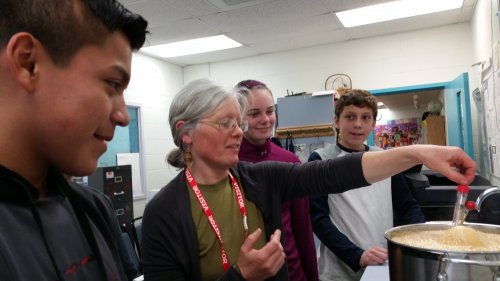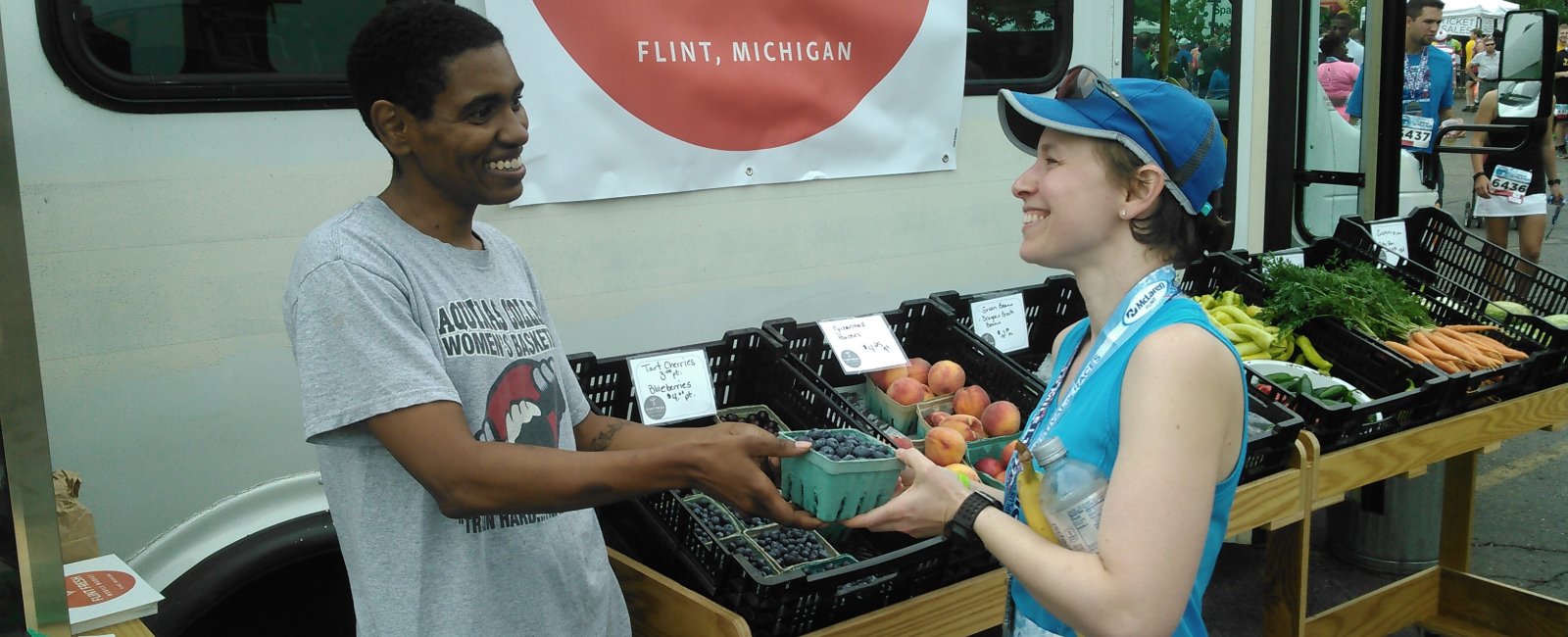Tax reporting for healthy food access programs
Takeaways
This guidance brief provides an overview of the reporting categories on IRS Form 990 Schedule H, as well as some guidelines and “rules of thumb” for how to report community benefit support for a set of healthy food access initiatives discussed throughout this playbook.
These programs can be an effective component of community benefit implementation strategies to address priority community health needs including obesity, food insecurity, healthy food access, poor nutrition, and diet-related health conditions.
Hospital community benefit includes services and initiatives undertaken to improve community health. Nonprofit hospitals are required to maintain community benefit programs in order to meet their obligations for tax-exempt status. The Internal Revenue Service (IRS) requires nonprofit hospitals to document their community benefit contributions and activities on Form 990 Schedule H each year.
Schedule H allows hospitals to report two broad types of expenses under the community benefit standard: 1) charity care and unreimbursed costs of providing care to Medicaid patients and other beneficiaries of means-tested government health programs and 2) other community benefit services.
Charity care includes costs of treating patients who meet the organization’s criteria for financial assistance. Community benefit services include the costs of community health improvement activities, educating health professionals, subsidizing health services, research, financial and in-kind contributions, and community benefit operations.
Health care facilities can play a valuable role in increasing access to healthy foods and promoting healthy and sustainable food systems. This guidance brief provides some guidelines and recommendations for reporting community benefit support for a set of healthy food access initiatives discussed throughout this playbook.
These programs can be an effective component of community benefit implementation strategies to address priority community health needs including obesity, food insecurity, healthy food access, poor nutrition, and diet-related health conditions.
Community health needs
According to the Final Rule (Additional Requirements for Tax-Exempt Hospitals), the health needs a tax-exempt hospital may consider in its community health needs assessment include not only the need to address financial and other barriers to care but also the need to prevent illness, to ensure adequate nutrition, or to address social, behavioral, and environmental factors that influence health in the community.
The IRS currently distinguishes between community health improvement activities that should be reported as community benefit in Part I of Schedule H from “community building” initiatives that should be reported in Part II (community development activities, which are relegated to a separate category in Schedule H).1
Community building activities include physical improvements and housing, economic development, community support, environmental improvements, leadership development and training for community members, coalition building, community health improvement advocacy, and workforce development.
Yet a substantial body of research demonstrates that a clean, safe place to live, reliable access to healthy food, and employment opportunities have a profound effect on health. For low-income communities, support for these basic needs can be as important as providing free medical care.
In 2011, the IRS amended its Schedule H instructions, saying that some community building activities listed in Part II of Schedule H can be reported, and “count,” as community benefit activities in Part I.2
The IRS further clarified in a December 2015 IRS Executive Order Update, which stated:
"...some housing improvements and other spending on social determinants of health that meet a documented community health need may qualify as community benefit for the purposes of meeting the community benefit standard."
The Catholic Health Association (CHA) provides detailed resources and recommendations for community benefit reporting, including guidance on when support for community building initiatives can be reported as community benefit (in Part I of Schedule H).
Key terms in Schedule H (Form 990)
Community health improvement services [Part I]: activities or programs, subsidized by the health care organization, carried out or supported for the express purpose of improving community health.
To be reported, community need for the activity or program must be established. IRS instructions say that community need may be demonstrated through the following:
- A community health needs assessment (CHNA) conducted or accessed by the organization;
- Documentation that demonstrated community need or a request from a public health agency or community group was the basis for initiating or continuing the activity or program;
- The involvement of unrelated, collaborative tax-exempt or government organizations as partners in the activity or program carried out for the express purpose of improving community health.
Community benefit activities or programs also seek to achieve a community benefit objective, including improving access to health services, enhancing public health, advancing increased general knowledge, and relief of a government burden to improve health.
Community building activities [Part II]: Physical improvements and housing, economic development, community support, environmental improvements, leadership development and training for community members, coalition building, community health improvement advocacy, workforce development, and other.3

Core guidelines:
- Community health improvement and other community benefit activities reported in Part I must meet a demonstrated health need in the community.
- Distinct sections of the reporting form are used to report expenditures for community health improvement activities, in-kind-contributions,4 and cash contributions. The use of cash contributions have to be restricted in writing.
- It is recommended that hospitals give priority to initiatives designed and implemented to serve vulnerable populations.
- Staff time can only be counted as community benefit if it is paid staff time. It’s wonderful for hospital staff to volunteer for a worthy cause, but volunteer hours should not be counted.
- Any program or activity that is being offered to attract or retain patients, or to primarily benefit those patients, should not be counted as community benefit.
- Expenses incurred in the course of normal hospital operations should not be reported, including costs associated with improving hospital food service or delivering the facility’s standard of care.
- Programs and initiatives to promote employee wellness are an important part of hospitals’ and health systems’ broader commitment to community health. For example, employee participation in community supported agriculture (CSA) programs promote good health, support local producers, and set a great example for the rest of the community. However, expenditures for these activities should not be reported as community benefit on Schedule H.
Reporting guidance for selected healthy food access interventions
Food banks and pantries
Food banks and pantries provide critical food assistance to economically disadvantaged individuals and families when they need it most. There are a variety of ways that hospitals can partner with local food banks to combat food insecurity and reduce risk of diet-related health conditions, particularly by helping to expand food pantries’ offerings of fresh, healthy food.
To be reported as community benefit, activities need to respond to an established community need.
Conduct health screenings or food insecurity screenings
Food insecurity and health screenings can count in Part I, except when provided exclusively to patients, staff, or for marketing purposes.
Fund or lead food and nutrition classes
Food and nutrition education is countable in Part I when it is provided with paid staff hours, it is not being provided for more than a nominal fee, and is available to non-patients as well as patients.
Help food banks develop nutrition policies
Paid staff time to assist with crafting nutrition policies is countable in Part I.
Offer financial support to purchase refrigerators for fresh foods
Financial support for the purchasing of refrigerators for the food bank or pantry is countable in Part I, as long as the refrigerator is not for hospital operations use.
Establish a food pantry on hospital campus
Establishing a food pantry on the hospital grounds can be reported in Part I if provided primarily to benefit the community.
Offer financial support for mobile pantry vehicle
Funding for a mobile pantry vehicle is countable in Part I as long as it serves a population with a demonstrated need.
Hospital garden provides fruit and vegetable donations to local food banks
Costs associated with a hospital garden providing produce donations to food banks/pantries can be reported Part I, however, the expenses associated with these donations should be distinguished from produce for hospital food service or staff.
Commit staff time to connect local farmers and food banks
Staff time and resources to connect local farmers and food banks is is countable in Part 1 as long as it meets an identified community need.
Fruit and vegetable incentive programs
Fruit and vegetable incentive programs (FVRx) increase produce purchasing power for individuals and families who are experiencing food insecurity or suffering from one or more diet-related health conditions by providing coupons that can be redeemed for healthy foods from local vendors. These programs are often coupled with nutrition education to encourage sustained behavior change. Hospital community benefit programs can participate in fruit and vegetable incentive programs in several ways, including providing financial support for the vouchers and other roles in implementing the programs.
To be reported as community benefit, activities need to respond to an established community need.
Conduct health and/or food insecurity screenings to determine eligibility for enrollment
Health and/or food insecurity screenings used to determine eligibility for FVRx programs can count in Part I if they are provided to address a community health need, are not provided only to hospital patients, and are not used to encourage patients to use the services of the hospital providing the screenings (i.e. used for marketing purposes).
Enroll participants and distribute prescriptions
Staff time to enroll participants and distribute FVRx vouchers can count in Part I, particularly if the program serves the community at large and not only hospital patients. Staff time to implement FVRx programs for patients can count if the program addresses priority needs and provides services above and beyond the normal standard of care for a vulnerable population.
Provide grant support to fund the incentive coupons
Grant support for a fresh produce incentive program is countable if the program targets an identified health need for a vulnerable population
Provide staff time/technical assistance to develop grant proposals to secure additional incentive funding
Staff time used to develop grant proposals for additional produce incentive program funding is countable in Part I.
Operate a produce distribution point for coupon redemptions
Operating a produce distribution point for coupon redemptions is countable in Part I provided that the program targets an identified health need for a vulnerable population
Conduct diet and nutrition education
Food and nutrition education is countable in Part I when it is provided with paid staff hours, it is not being provided for more than a nominal fee, and is available to non-patients as well as patients.
Assist with data collection, data analysis, and evaluation
Assistance with data collection/analysis/evaluation of FVRx programs can be counted in Part I if it is conducted using paid staff time.
Farmers markets and mobile markets
Farmers markets can help to increase access to healthy foods, particularly when located in vulnerable communities and when paired with a fruit and vegetable incentive program or when the market accepts SNAP and WIC benefits. Mobile markets can help to further the impact of farmers markets by delivering fresh produce to low-income neighborhoods. Hospital community benefit programs can support farmers markets and mobile markets in numerous ways. If the hospital is located in an area with inadequate access to fresh, healthy food, hosting a farmers market for community members on hospital grounds can be an effective strategy. Community benefit resources can purchase and maintain mobile market vehicles and hospital staff can lead nutrition education classes.
To be reported as community benefit, activities need to respond to an established community need.
Host a farmers market on the hospital campus
Support for a farmers market hosted on the hospital campus is countable in Part I provided that the market is located in an area with a demonstrated community need for increased healthy food access.
Provide financial support for mobile market vehicle
Financial support for a mobile market vehicle is countable in Part I if is serves a vulnerable population.
Fund or lead food and nutrition classes
Food and nutrition education is countable in Part I when it is provided with paid staff hours, it is not being provided for more than a nominal fee, and is available to non-patients as well as patients.
Conduct health screenings or food insecurity screenings
Food insecurity and health screenings count in Part I, except when provided exclusively to patients, staff, or for marketing purposes
Assist with data collection, data analysis, and evaluation
Assistance with data collection/analysis/evaluation of farmers market or mobile market programs related to community nutrition/food needs can be counted in Part 1 if it is conducted using paid staff time.
Community supported agriculture programs
Community supported agriculture (CSA) programs can increase access to fresh fruits and vegetables, especially when produce is distributed at convenient community-based locations in underserved communities and when CSA shares are subsidized for eligible community members. Hospital community benefit can support CSA programs in several ways, for example, subsidizing shares for low-income families can be an effective way to increase access to healthy foods.
To be reported as community benefit, activities need to respond to an established community need.
Host a CSA distribution site
Hosting a CSA distribution site is countable in Part 1 as long as it meets a demonstrated community need and serves a vulnerable population.
Offer staff or financial support for subsidized CSA program or purchase CSA shares for food insecure families
Staff and financial support for subsidized CSA programs is countable in Part I as long as the program serves members of vulnerable populations is not restricted to staff and patients, is not being conducted for marketing purposes, and meets a demonstrated community need.

Community gardens and farms
Community gardens and farms, especially those located in urban areas, can increase access to healthy foods while simultaneously improving knowledge of planting, growing, and harvesting fruits and vegetables. Food, nutrition, and cooking education can easily be incorporated into these initiatives, furthering participant knowledge. Urban farms can offer additional benefits including job creation, workforce development training, and continuing education opportunities.
To be reported as community benefit, activities need to respond to an established community need.
Host or provide space for a community garden or farm on hospital property
Hosting or providing space for a community garden or farm on hospital property is countable in Part I provided that the produce is used to meet the needs of vulnerable individuals and households rather than primarily used for hospital food service or staff.
Offer opportunities for workforce development
Workforce development provided in association with a community farm or garden would be best documented in Part II.
Provide financial support or staff time for a community garden
May include provide funding to buy tools, fencing, or other materials to help get a community garden up and running.
Providing paid staff time and/or financial support for a community garden is countable in Part I if the garden meets a demonstrated community need and serves a vulnerable population.
Lead or fund diet and nutrition education
Food and nutrition education is countable in Part I when it is provided with paid staff hours, it is not being provided for more than a nominal fee, and is available to non-patients as well as patients.
Food policy councils
A food policy council (FPC) is a group of stakeholders from across the food system that includes a diversity of sectors and industries as well as private, public, and nonprofit organizations. Food policy councils have a variety of food-related goals including improving healthy food access, addressing food security, and supporting local and sustainable food producers. Council member organizations can be valuable partners in healthy food access initiatives.
To be reported as community benefit, activities need to respond to an established community need.
Support the legislative policy initiatives of food policy councils
Support the legislative policy initiatives of FPCs This can include technical assistance with developing surveys, staff time to administer surveys, financial support for the assessment project, or sharing hospital data. The findings can be included in the hospital’s community health needs assessment. This can also include signing letters of support for legislation, providing testimony at hearings, and providing staff time to support advocacy efforts. Hospitals, as anchor institutions and large employers, hold significant political capital with policymakers and their support can lend important credibility to policy efforts.
Paid staff time or funding to support FPCs to conduct food assessments is countable in Part I.
Support other initiatives, projects, or capacity building for councils with funding or in-kind support
Support other initiatives, projects, or capacity building for councils with funding or in-kind support, such as providing meeting space, assisting with technology or communications, or providing grants.
Support for the legislative policy initiatives of FPCs may be reported in Part II, or in Part I if they address a demonstrated community need.
Provide support for community benefit staff to serve on a food policy councils
Provide support for community benefit staff to serve on a FPC as members or on committees
If the efforts are intended to address a demonstrated community health need, supporting council initiatives, projects, or capacity building with funding or the provision of meeting space is countable in Part I. Assistance with technology or communications is countable in Part I if it is provided by paid staff.
If there is no food policy councils in your region, support efforts to develop a council
If there is no FPC in your region, support efforts to develop a council by convening stakeholders and supporting planning and lobbying efforts to create a council.
- Paid hospital staff time to serve on an FPC is countable in Part I
- Supporting efforts to develop a FPC by convening stakeholders, supporting planning, or lobbying may be reported in Part II.

School meals
The U.S. Department of Agriculture’s National School Lunch Program and School Breakfast Program are designed to ensure children have access to nutritious, school-based meals and are an important safety net for children from low-income households. School meal programs present an opportunity for hospitals to support well-established efforts that have been proven effective at promoting children’s health and in alleviating food insecurity. Food and nutrition education and policy advocacy can complement federally funded school meal programs.
To be reported as community benefit, activities need to respond to an established community need.
Coordinate community coalition to enhance capacity of schools to serve a high quality of meals
Paid staff time to enhance school meal efforts can count in Part I if they address a demonstrated community health need.
Conduct nutrition, food, and cooking education
Food and nutrition education is countable in Part I when it is provided with paid staff hours, it is not being provided for more than a nominal fee, and it is provided primarily to benefit the community.
Provide financial/grant support
Financial/grant support for enhancing school meal programs is countable in Part I.
Contribute materials/equipment
Contribution of materials/equipment to school meal programs is countable in Part I.
Summer, weekend, and afterschool meal and snack programs
Summer, after school, weekend, and meal bag/backpack programs give low-income children access to nutritious foods when school is not in session. Hospitals can host or provide support to programs hosted at other community sites through the U.S. Department of Agriculture Summer Nutrition Program and the Child and Adult Day Care Program’s At-Risk Afterschool initiatives. Health care facilities can also promote program participation in a variety of ways.
To be reported as community benefit, activities need to respond to an established community need.
Sponsor a USDA Child Nutrition meal site
Sponsor a USDA Child Nutrition meal site for summer meals or at-risk afterschool meals
Paid staff time and financial or in-kind support to provide educational or recreational activities to enhance federally funded meal and snack programs, or to provide transportation for participants, can count in Part I. While facilities hosting these meal programs are reimbursed, additional support and activities to extend the reach or appeal of the programs can be reported in Part I.
Partner with community organizations to support USDA meal site implementation
Partner with community organizations to support USDA meal site implementation
Paid staff time and financial or in-kind support to provide educational or recreational activities to enhance federally funded meal and snack programs, or to provide transportation for participants, can count in Part I. While facilities hosting these meal programs are reimbursed, additional support and activities to extend the reach or appeal of the programs can be reported in Part I.
Farm to school
Farm-to-school initiatives increase access to fresh, healthy, local food and promote healthier dietary behaviors. Farm-to-school programs provide additional benefits to the community by increasing revenue for local farmers and keeping dollars circulating in the local economy. Hospital support for farm-to-school activities can take the form of financial contributions to fund program activities, staff conducting food and nutrition education, and technical assistance to support local purchasing.
To be reported as community benefit, activities need to respond to an established community need.
Play coordinating role in expanding community’s farm-to-school initiatives
Paid staff time spent coordinating the expansion of the community’s farm-to-school initiatives is countable in Part I if it addresses an identified community need.
Conduct food, nutrition, cooking education
Food and nutrition education is countable in Part I when it is provided with paid staff hours, it is not being provided for more than a nominal fee, and is available to non-patients as well as patients.
Provide grant support for school garden
Providing grant support for a school garden is countable in Part I as long as the program responds to a demonstrated community need.
Provide staff time and technical assistance to develop grant proposals to secure additional program funding
Staff time and technical assistance with developing grant proposals for additional program funding is countable in Part I.
Healthier corner stores
Healthier corner store initiatives aim to improve the accessibility and affordability of healthy food and beverage options in small store settings. These programs have multiple components including increasing the inventory of healthy food and beverage options, advocating for more accurate and informative labeling, and educating customers on healthy food choices. Hospital community benefit programs can participate in healthy corner store initiatives in several ways, including assisting with healthy food marketing materials and providing health screenings or nutrition education activities.
To be reported as community benefit, activities need to respond to an established community need.
Provide resources and materials to promote healthy options in corner store initiatives
Provide resources and materials to promote healthy options in corner store initiatives.
In-kind donations or cash contributions to promote healthy options in corner store initiatives are countable in Part I.
Coordinate initiative to increase access to healthy foods in neighborhood stores
Coordinate initiative to increase access to healthy foods in neighborhood stores.
Staff time spent coordinating initiatives to increase access to healthy foods in neighborhood stores is countable in Part I when the initiative responds to an identified community health need.
Provide financial or staff support for fruit and vegetable incentives
Provide financial or staff support for fruit and vegetable incentives that can be redeemed in corner stores in low-income or food desert communities.
Financial or staff support for fruit and vegetable incentives to be redeemed in corner stores can be counted in Part I.
Learn more
- The Catholic Health Association (CHA) offers a variety of resources and recommendations for community benefit reporting (see Chapters 2 and 4 on “what counts” and community benefit, respectively, in A Guide for Planning and Reporting Community Benefit), as well as guidance as to when support for community building initiatives can be reported as community benefit-community health improvement (in Part I of Schedule H). Detailed answers to specific reporting questions can be found in CHA’s “What Counts” Q&A Index.
- The Internal Revenue Service (IRS) offers official reporting instructions and access to the Schedule H document itself
- For searchable Schedule H data from specific tax-exempt hospitals across the nation, see the Robert Wood Johnson Foundation’s Community Benefit Insight tool, developed in conjunction with the Research Triangle Institute and the Public Health Institute.
